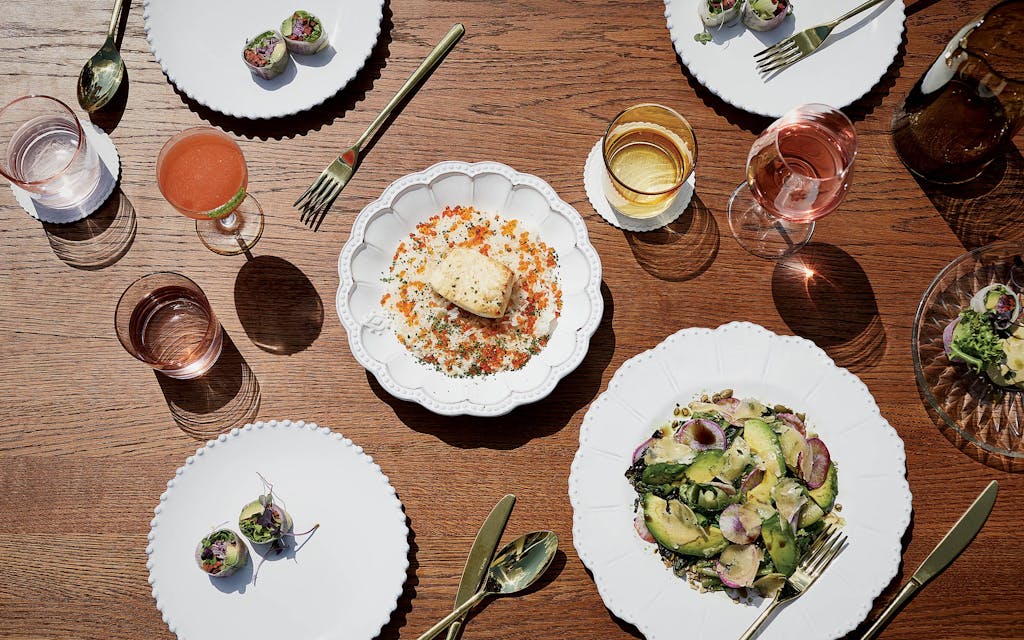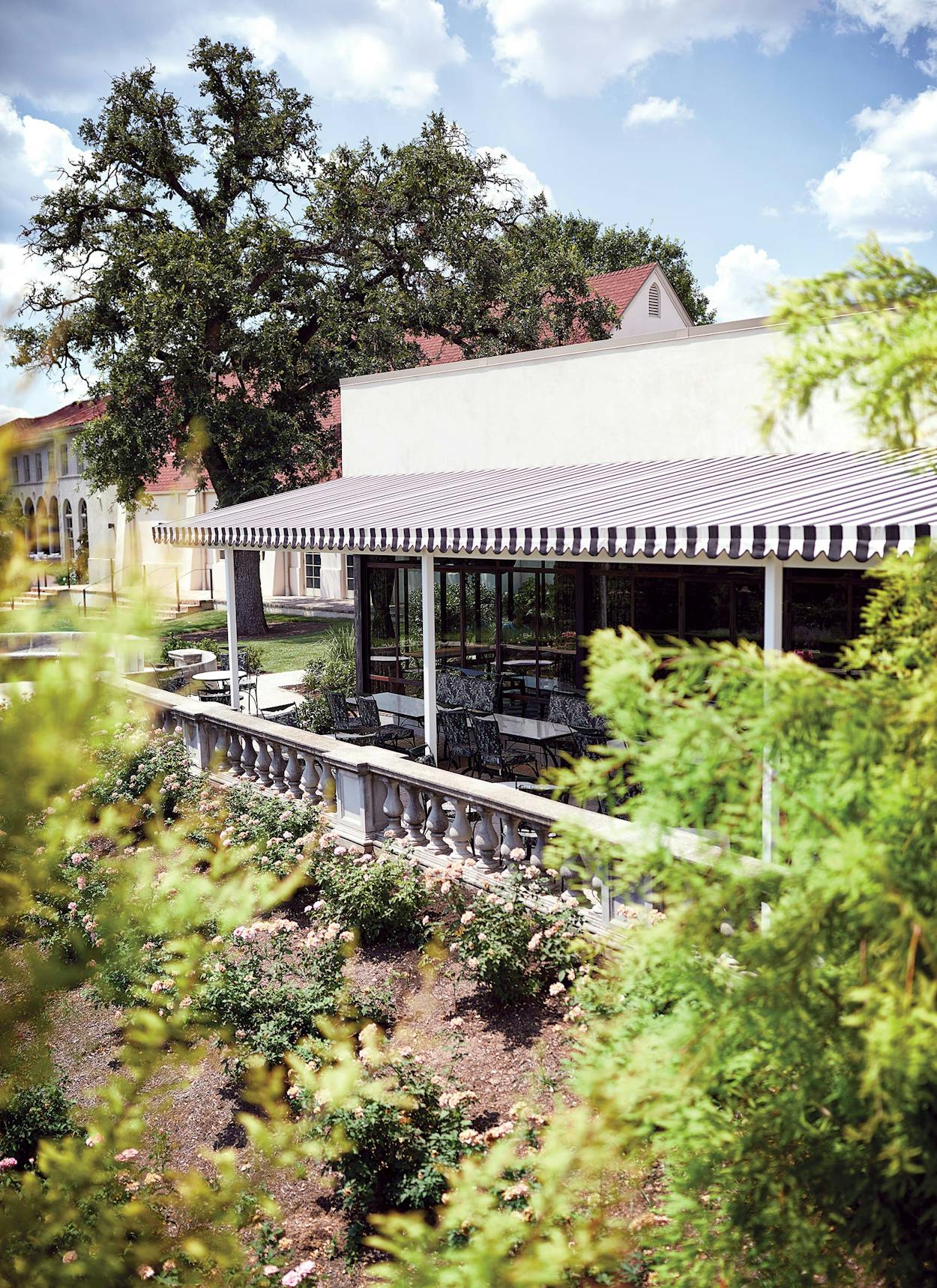If you have time to dine at only one adorable new restaurant overlooking the lovely gardens of a meticulously restored Mediterranean Revival villa built in 1928 by a wealthy Texas cotton magnate and his socialite wife, let it be Lutie’s. The jewel box of a dining room, boasting a chic black-and-white tile floor and a veritable rain forest of plants, is the centerpiece of a historic Austin property known as the Commodore Perry Estate. Because it is finally open after a year’s delay (thanks, of course, to COVID-19) and because its prestigious chefs have Michelin-starred kitchens on their résumés, Lutie’s has been getting the kind of fanatical attention that Texans normally devote to our best barbecue joints. Reservations are so scarce that the truly desperate are making them online at midnight three months in advance, the instant a new batch becomes available. And if you’re thinking you can just show up and find an empty table, forget it. There’s a cancellation wait list too.
For longtime Austin residents like me, the stately old Perry place has been a source of both curiosity and mystery. (In my case, the mystery was personal. I grew up near Red River Street, and for years my family would wonder where our dog, Ranger, went after breakfast every day—dogs were allowed to roam free then. It turned out he would trot four blocks to the Perry mansion and hang out with the students and nuns at the Catholic girls’ school that then operated on the property. “We call him Bozo!” they told us. “Perfect,” my father said. “That dog is definitely a clown.”) Hidden away behind stone walls on ten lush acres in what is now Central Austin, the graceful Italianate structure began its life as the country home of a prominent family headed by civic leader Edgar Perry and his vivacious wife, Lutie. The couple lived there for fifteen years, raising a family and entertaining the city’s movers and shakers. In 1944 they sold the place, and over the next few decades it survived as a succession of private schools and then as an event space.
Those decades, however, were not kind. The red-tile roof was leaking and raccoons had moved into the attic when, in 2011, a group of developers led by a sentimental former student staged a rescue, just in time to keep the building from becoming the Miss Havisham of local historic properties. Today, following millions of dollars of renovation, the old girl looks better than she has in more than ninety years. The mansion now houses elegant suites that are part of a newly constructed boutique hotel. And Lutie’s, in its own little glass-fronted building, is the hostelry’s showcase restaurant.


History was not on our minds, however, when three friends and I settled into a spacious corner banquette one recent evening. What had our rapt attention was the concise menu by classically trained chefs Bradley Nicholson and Susana Querejazu. Given the opportunity to run the kitchen at Lutie’s, the husband and wife had returned to Austin (where they’d begun their careers together at Vespaio and Barley Swine) from San Francisco (where they’d worked, respectively, at Benu and Saison).
Because their vegetable-forward menu takes plants in new and sophisticated directions, we began with the Garden Hand Rolls, which turned out to be as pretty as an Impressionist painting, with translucent sheets of purple-edged daikon radish wrapped around neatly bundled sticks of raw carrot, avocado, zucchini, and more; each packet was then sliced into colorful bite-size coins. An accompanying pool of cool-green cucumber-basil aioli added just the right touch of luxury.
If the rolls were the essence of fresh and bright, the garnet-hued beets were the epitome of decadent. The key to their sybaritic texture was five hours of low cooking with black garlic and shallots, followed by generous ladles of seasoned clarified butter. Another novel turn is simply called Green Dish, which takes a seasonal vegetable (carrots on our visit) and immerses it in a savory broth based on kombu (kelp) and spinach that has been kicked up a notch with green onion, ginger, and jalapeño. When I asked Nicholson if any of the vegetables were grown on the property, he said they weren’t but that large gardens were definitely part of future plans.
But just because vegetables take leading roles at the aptly named Lutie’s Garden Restaurant, you shouldn’t assume there is no hearty animal protein to be had. One of the most gratifying choices is roasted pork, which comes from Yonder Way Farm, in Fayetteville. The cut varies from day to day because the kitchen does its own butchery, and we lucked into luxurious grilled pork belly sided by fresh creamer peas and cabbage unlike any I’d had before. Nicholson had pickled it, somehow melding the high, lively notes of kimchi and the deeper, autumnal ones of sauerkraut. The flavor was striking on its own, and the pickling liquid gave the rich pork broth a sassy kick.
We considered beef—again, the cut varies, which may frustrate steak lovers—but went for quail. The bird was small, even by quail standards, and its legs had dried out during their time on the charcoal grill. The tiny breast, however, was perfectly tender. The best part of the ensemble, though, was—no surprise—the vegetable sides: grilled leeks and hominy. Made in-house, the hominy was (happily) unrecognizable as such, masquerading as small, bouncy kernels lavished with butter and chile vinegar.

On any given day, there are three seafood choices at Lutie’s, and on this visit (and another a week later) I tried two of them. My second-favorite was a genteel rendition of New Orleans barbecued shrimp, which despite the name have nothing to do with smoke. The shellfish involved are Royal Reds, netted in deep water off the Gulf and Atlantic coasts, and they’re actually pink. To season the critters, Nicholson starts with a classic shrimp stock that he hits with house-made hot sauce, sugar, and tomato, then adds a splash of spicy brown butter. When my friends and I had speared every last rosy crustacean, there was still a generous puddle of sauce on the plate, which went great with the accompanying side of pickled daikon and chopped celery leaves.
As good as the shrimp were, though, my favorite seafood selection was the brilliant treatment of fish (black cod on my visit) atop heirloom rice. The silken, white-fleshed filet had been fastidiously cooked, but it was the Mississippi-grown Delta Blues rice, in a swirl of cultured butter with rice wine vinegar and a hint of soy sauce, that all but stole the show. On top of both fish and rice was a delightful sprinkle of orange trout roe, each egg popping when we bit into it like a tiny, salty water balloon.
My friends and I were sated by the end of the meal, but Querejazu’s intriguing desserts—such as the Bees Wax Crème Caramel, to name just one—demanded to be tried. We decided to share it, and the instant it arrived we each took a bite. The pale gold custard was its usual lush self, but it also had a subtle floral undertone that tasted like summer. What was that flavor? It turned out Querejazu had immersed chunks of beeswax in the French dessert’s milky base. She used the same infusion trick in a novel two-part chocolate dessert that featured a scoop of chocolate ice cream snuggled up to a mound of sweet-salty fried cocoa nibs. Crowning the pairing was a generous spoonful of cream that had also spent some quality time with cocoa nibs, which gave it a voluptuous, tangy note.
At the end of my first visit to Lutie’s, I’d found the whole experience so pleasant that I didn’t want to leave. So I didn’t—at least not right away. After I said goodbye to my friends, I settled in for a postprandial drink; the sultry Luna de Sangre, made with reposado tequila, grapefruit, and blood orange, was just right. Then I took a leisurely walk along the garden paths, idly imagining whether I’d choose to stay in one of the new Auberge Resort Collection hotel’s 42 rooms and 7 suites or one of the 5 suites in the historic manse. Personally, I doubted I would be sleeping in any of them anytime soon, given that rates typically start at more than $500 a night, but I did reflect on how lucky Austin is that the charming grounds didn’t end up housing a shopping center or apartment complex. It made me happy to think that the Commodore Perry Estate has been returned to its former glory and then some, and that laughter is once again echoing across perfectly trimmed lawns, just the way it did when the place was young, nearly a century ago.
Lutie’s
4100 Red River, Austin
512-675-2517
D Wed–Sun.
$$$
Opened April 7, 2021
This article originally appeared in the August 2021 issue of Texas Monthly with the headline “Garden Party.” Subscribe today.
- More About:
- Pat’s Pick
- Austin









